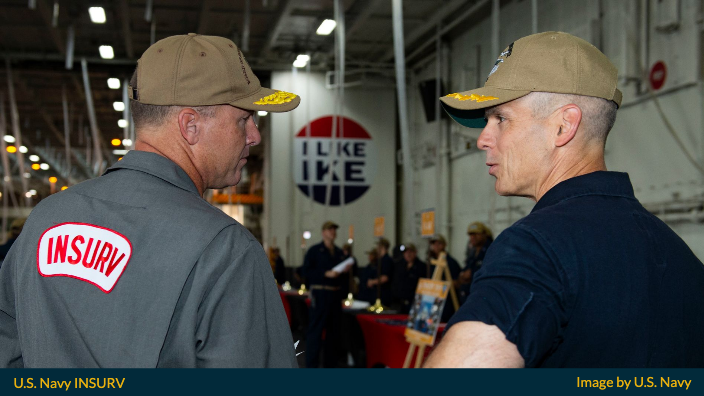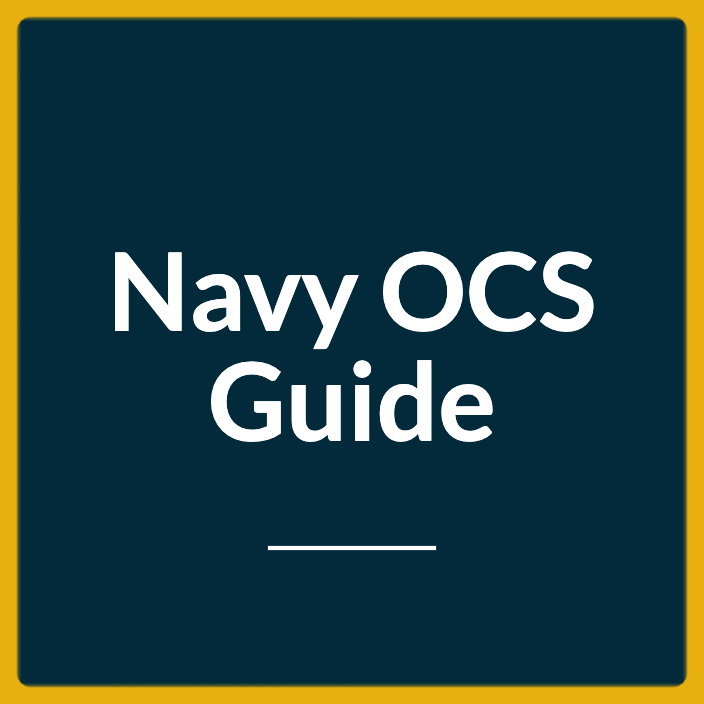Last Updated on March 4, 2024
When pondering a career as a Navy officer or just wanting to understand the complex machinery that keeps the Navy running smoothly, INSURV is a term you’ll repeatedly encounter. INSURV stands for the Board of Inspection and Survey.
This isn’t just another acronym in the sea of military jargon; INSURV is a foundational element of naval readiness and operational capability.
This article will dive into every facet of INSURV, explaining why it’s indispensable for Navy officers and how it works in exhaustive detail.
If you’ve ever wondered about the robust processes that keep the U.S. Navy at the pinnacle of maritime power, you’ve come to the right place.
What is INSURV? A Quick Overview
INSURV is an all-encompassing inspection program within the U.S. Navy, designed to rigorously assess whether naval vessels meet stringent standards of material readiness.

At its core, INSURV serves as a comprehensive inspection and assessment program within the U.S. Navy. Under this program, a team of highly qualified naval experts evaluates naval ships.
These inspections cover a broad spectrum—everything from the structural integrity of the ship’s hull to the efficiency of communication systems is scrutinized.
This isn’t just a mere check-up; it’s a rigorous assessment aimed at confirming that every vessel in the Navy’s extensive fleet is seaworthy, operational, and prepared for any contingencies.
Historical Context: The Genesis of INSURV
If you think INSURV is a recent invention, think again. The program was initially established by the U.S. Congress way back in 1882.
That’s a long history, dating almost 150 years, underlining the program’s deep-seated role in ensuring a capable and operational naval force.
Although technology and naval warfare have dramatically evolved since the 19th century, the core goal of INSURV has remained consistent: ensuring every ship, from aircraft carriers to submarines, meets the highest standards of readiness for national defense.
Why INSURV Matters for Navy Officers
You may ask, “Why should I care about INSURV if I’m considering a career as a Navy officer?”
Well, let’s unpack why INSURV holds immense importance to officers:
Career Progression
Excelling in INSURV inspections can significantly impact your career trajectory. Superior performance in these inspections is often considered during promotion assessments and when selecting officers for more prestigious assignments.
Those who show expertise in INSURV inspections may find themselves with increased responsibility and leadership opportunities, such as shipboard command positions.
A Commanding Officer ensures the material condition of their vessel is up to standards, and having a thorough knowledge of INSURV inspections can give an officer an edge over the competition.
Those with a robust understanding of INSURV inspections may be sought after for specialized roles, such as technical experts, trainers, and evaluators.
Operational Readiness
The key result of a successful INSURV inspection is the declaration that a ship is operationally ready for battle. In a world of ever-changing geopolitical dynamics, the preparedness of each vessel is critical for national security.
Operational readiness is defined as the ability of a vessel to perform its assigned missions in an efficient and timely manner.
To achieve this state, there are many requirements that must be met. These include ensuring that the ship is equipped with the right tools and equipment, has trained personnel with the skills, and that it has all of its needed supplies and parts.
During an INSURV inspection, personnel are evaluated to ensure the crew’s knowledge and proficiency is up to par.
A series of tests and evaluations are conducted on the ship’s systems and equipment.
If any deficiencies are identified during the inspection, they must be addressed before the ship can be declared operationally ready.
Resource Allocation
The findings from INSURV inspections feed into larger naval strategy, influencing decisions on budget allocations and resource distributions. Your ship’s performance can guide where the Navy invests its future resources.
The Navy uses the inspection results to gain insight into the overall performance and condition of a ship. This information helps inform decisions on budget allocations and resource distribution throughout the navy.
Resource allocation is an important part of sound naval strategy. Each ship needs to be properly maintained and supplied with the right personnel and tools for it to perform its assigned duties. I
NSURV inspections help ensure this is the case, and their findings can make or break a vessel’s mission readiness.
What Does the INSURV Process Entail?
INSURV isn’t a one-and-done event; it’s a continuum that can be broadly categorized into three main phases.
Pre-Inspection Preparations
Long before the INSURV team sets foot on your vessel, there’s a laundry list of tasks that officers and crew must complete.
Over several months, you’ll be occupied with reviewing all the ship’s mechanical and operational systems, fixing any deficiencies, and ensuring that all equipment is in top-notch condition.
Mock inspections are often carried out to simulate the actual INSURV, providing valuable insights into potential areas for improvement.
The Inspection Phase
When D-Day arrives, a specialized INSURV team, typically headed by a seasoned Navy Captain with years of experience, descends upon the ship. Over a period of several days, these experts will delve into a myriad of areas:
- Engineering Systems: The functioning and maintenance protocols of the ship’s engines are scrutinized.
- Weapons Systems: Each onboard weapon, from anti-aircraft systems to torpedoes, is tested for functionality and readiness.
- Navigational Systems: The team evaluates the accuracy and reliability of radar, sonar, and GPS systems, ensuring the ship can safely navigate in all conditions.
- Living Conditions: Quality of life is also a focus, covering aspects like food services, sanitation, and medical facilities.
Post-Inspection Follow-up
Once the intense scrutiny is over, the INSURV team compiles a comprehensive report.
This document is not merely a scorecard; it offers a diagnostic evaluation of the ship’s condition, highlighting areas where the crew excelled and outlining recommendations for areas that need improvement.
If a ship fails the INSURV, remedial actions are immediately brought up to standard.
How to Prepare for INSURV: Tips for Navy Officers
The INSURV process can be intimidating, but as an officer, your leadership and preparedness can make all the difference. Here are key strategies to ensure you’re well-prepared:
- Thoroughly Review Systems: Don’t just skim through the manuals. Engage with them and familiarize yourself with every nook and cranny of your ship’s systems.
- Conduct Drills: Regular drills can help your crew identify weaknesses and improve performance under the kinds of pressures they’ll face during the real inspection.
- Stay Updated: INSURV protocols aren’t static. Monitor any updates to the INSURV instruction manual to stay abreast of changes.
- Team Effort: Cultivate a culture of excellence among your crew. INSURV is a team endeavor, and everyone from the highest-ranking officer to the newest recruit plays a part.
A Real-Life Example: INSURV on the USS John C. Stennis
To provide a tangible perspective, let’s consider the INSURV inspection on the USS John C. Stennis in 2018. This aircraft carrier successfully completed its INSURV with flying colors.
The INSURV team lauded the ship’s readiness levels, especially in engineering systems and the quality of life for the crew.
This serves as a robust example of how detailed preparation and a commitment to excellence can lead not just to passing INSURV, but to standing out in it.
Conclusion: INSURV—Not Just Another Inspection
INSURV is a cornerstone on the foundation of the U.S. Navy’s unmatched maritime strength. It serves as a rigorous, multi-layered evaluation process designed to ensure every ship and its crew are battle-ready.
For Navy officers, understanding INSURV isn’t a mere formality; it’s a professional obligation that impacts career growth, resource allocation, and, ultimately, national security.
So, whether you’re an experienced officer or planning to embark on a naval career, a deep understanding of INSURV is invaluable. Remember, a well-prepared ship is formidable, and INSURV ensures you are up to the task.


